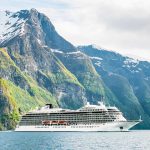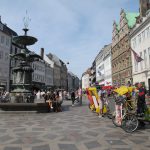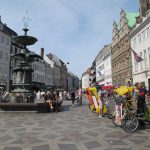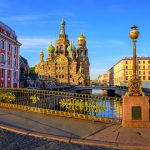Helsinki, capital and largest city of Finland, is one of the least appreciated ports of call on a Baltic Sea cruise itinerary. It lacks a specific old town, such as seen in Tallinn, Estonia or Riga, Latvia. And it does not offer a royal palace with a changing of the guard as seen in Stockholm or Copenhagen. Yet this city with 1.4 million residents offers many hidden gems with regard to its early history along with being a dynamic modern urban center that is at the vanguard of 21st century design.
In 2012, Helsinki was named as the “Design Capital of the World,” and many visitors come to tour its numerous studios that feature varied household products and furniture, the most famous being Marimekko.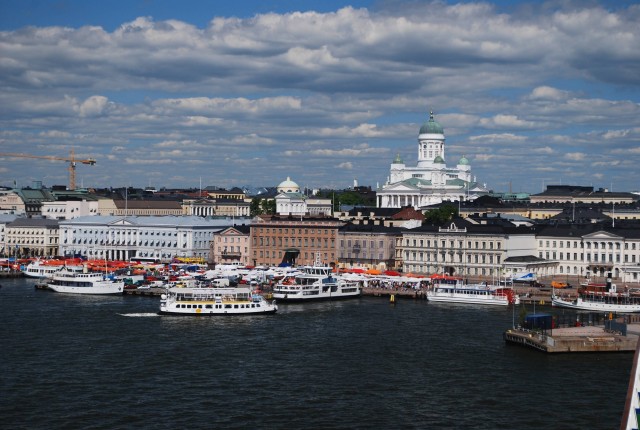 Helsinki occupies a central peninsula with large island studded bays on either side, and its major anchorages are quite calm and protected. The countryside was heavily glaciated, and there are large outcrops of ancient granite rock seen throughout the city, especially in its numerous parklands. And the landscape is dotted with numerous lakes and ponds as a result of glacial scour during the last major advance of the continental ice sheet.
Helsinki occupies a central peninsula with large island studded bays on either side, and its major anchorages are quite calm and protected. The countryside was heavily glaciated, and there are large outcrops of ancient granite rock seen throughout the city, especially in its numerous parklands. And the landscape is dotted with numerous lakes and ponds as a result of glacial scour during the last major advance of the continental ice sheet.
Located on the north shore of the Gulf of Finland directly opposite Tallinn, Estonia and situated on the last leg of the voyage to Saint Petersburg, Russia, Helsinki is a city whose history and architecture have been influenced by both Swedish and Russian occupation, the latter as late as 1917. The Swedish Empire established Helsinki (Helsingfors) as a trade competitor to Tallinn, which was a Hanseatic League city across the Gulf of Finland. But it never amounted to much with regard to trade, and then in 1710, it was devastated by plague.
Starting in 1748, the Swedish crown began construction of the island fortress of Sveaborg, better known today by its Finnish name of Suomenlinna as a bulwark against the Russian fortress of Kronstadt. But in 1809, the Russians invaded and captured Finland, incorporating into their empire until the Bolshevik Revolution of 1917 when Finland declared its independence. The Soviet leader Joseph Stalin was eager to take back Finland, but surprisingly in the first attempt just prior to World War II, the Red Army was beaten back by the tenacious Finns. But they were well aware that Stalin would try again. In stepped Nazi Germany and offered help, which the Finns reluctantly accepted. This resulted in keeping the Soviet Union at bay, but costing Finland war reparations at the end of World War II.
The Soviet leader Joseph Stalin was eager to take back Finland, but surprisingly in the first attempt just prior to World War II, the Red Army was beaten back by the tenacious Finns. But they were well aware that Stalin would try again. In stepped Nazi Germany and offered help, which the Finns reluctantly accepted. This resulted in keeping the Soviet Union at bay, but costing Finland war reparations at the end of World War II.
Helsinki was, however, awarded the 1952 summer Olympic Games, which helped focus positive attention on the city. And in the years since, Helsinki has become home to many high tech industries, a center for product design and an important stop on the Baltic Sea cruise itinerary. It is a delightfully clean and progressive city where English is a strong second language and visitors are made to feel very welcome.
Recently UNESCO noted that overall Finland has the strongest secondary education system in the world, and it was also considered to be one of the highest in science and mathematics. Helsinki University is considered one of the three finest institutions of higher learning in the Baltic Sea region. When you cruise to Helsinki, your docking location will be dependent upon the cruise line and size of the ship. Large cruise ships dock in the commercial harbor west of the city center and guests must use a shuttle bus to reach the city center.
When you cruise to Helsinki, your docking location will be dependent upon the cruise line and size of the ship. Large cruise ships dock in the commercial harbor west of the city center and guests must use a shuttle bus to reach the city center.
The smaller upmarket cruise ships of such lines as Regent, Seabourn and Silversea are able to dock in a small cove generally used by ferry boats, which is at the southern end of the Esplanadi, the main street of the city center. Passengers can disembark, walk through the open air market and then immediately begin to explore many of the important landmarks on their own unless they have chosen to participate in a group coach tour.
The major highlights of the city are for the most part within or adjacent to the city center. The sights not to be missed are:
- Suomennlina Fortress – The Swedish built fortress on an island offshore of the open air market at the foot of the Esplanadi is now a UNESCO World Heritage Site. Ferries run every few minutes and you can spend an hour or more on the island enjoying this massive fortress complex.
- Market Hall and Public Market – At the foot of the Esplanadi is the open air market selling fresh fruits, vegetables, fish and craft items. To the west is a red and yellow brick building that is the Market Hall where a great variety of prepared foods and baked goods can be purchased or eaten on site, as a great way to understand Finnish cuisine.
- The Esplanadi – This beautiful park that is frequented by locals all day is right in the heart of the city. It has sculptures, fountains and two excellent tea rooms, an oasis of calm in the middle of the city.
- Senate Square and the Lutheran Cathedral – Sitting atop a hill in the city center, the massive, white Romanesque Lutheran Cathedral is the most dominant building in the city center.

- Uspenski Cathedral – The red brick Russian Orthodox Cathedral is located on a hill overlooking the market square at the foot of the Esplanadi.
- Stockmann Department Store – The largest and most complete department store in the Baltic Sea region, Stockmann is not only a great place for Scandinavian clothing and design, but it has a food hall in the lower basement that can easily rival that of Harrod’s of London.
- Temppeliauko Kirkko – The rock church built inside one of the massive granite outcrops is a popular site because of the uniqueness of its construction. It is included in most tours and if you are on your own, it can be reached from the Esplanadi Park on the number two tram.
- Sibelius Park and Monument – Located along the waterfront just northwest of the city center is the ultra modern monument to Finland’s greatest classical composer.
- Olympic Stadium – Just north of the city center is the site of the 1952 summer Olympic Games, a major stadium still in use to the present.
- The Helsinki Railway Station – In the center of town is this classic example of Art Deco design from the 1930’s. It is a busy station with trains arriving and departing under a massive glass canopy.
- Botanical Gardens of Helsinki – Immediately to the east of the railway station is a quite oasis of the plants, trees and flowers that typify the countryside of Finland.

- Seurasaari Island Open Air Museum – Located a few miles northwest of the city center, easily reached by bus or taxi, this island park is a recreation of life in rural Finland over the past centuries. It is essentially a living museum and personnel dressed in traditional costumes demonstrate many of the lifestyle techniques from the past.
- National Museum of Finland – Located within walking distance of the Esplanadi, this beautiful museum, looking more like a cathedral from the outside, explores the physical, historic and cultural environments of Finland.
While out exploring Helsinki, be sure and stop for lunch. The quality and freshness of Finnish cuisine is sure to please even the most discriminating palate. Seafood, cheeses, a variety of breads and scrumptious desserts characterize the Finnish menu. My favorite spots for lunch are:
- Stockmann Department Store – The three main restaurants on the top floor of Stockmann Department Store are all run by the famous Karl Fazer Cafe, which will also be noted in a separate listing. But for a quick meal in surroundings that are not overly crowded either before or after the regular lunch hour, I highly recommend this as your lunch stop. There is a main restaurant with menu service, and it features the national soup – a creamy salmon and potato soup. There is a cafeteria serving a variety of hot entrees and the servers will explain the daily choices. The third option is an open face sandwich and dessert cafe. This self service section offers a variety of cold, open face sandwiches featuring beef, salmon and shrimp that are each a work of art. There are also slices of hot quiche. And the highlight is the cake and pastry section offering exquisite flavors.

- Karl Fazer Cafe – A venerable cafe located on Kluuvikatu between the Esplanadi Park and Aleksanterinkatu. Open seven days a week from 7:30 a.m. to 10 p.m., Karl Fazer Cafe is famous for its delectable open face sandwiches and rich delicious pastries. This is a self-service restaurant where you select the items you wish to eat from servers behind the line. Then you must find a table, which during much of the day can be daunting, but people are often willing to share if they are sitting alone and have empty chairs. But the quality of the sandwiches and desserts make it all worthwhile. In addition to light meal service, the cafe has a bakery and candy shop worthy of note.
- Restaurant Savotta – Located at Aleksanterinkatu number 22, opposite Senate Square, this small indoor-outdoor restaurant features traditional Finnish cuisine served in a friendly and casual atmosphere. Their menu includes traditional milk and salmon soup, fresh fish, wild game and tempting fruit desserts, all prepared in the manner of a traditional farm, using fresh ingredients. I have eaten at Savotta at least once every summer during visits to Helsinki and I have never had anything less than a superb meal. Savotta is open from noon to 11 p.m. Reservations are advised.
- Restaurant Savu – Located on a tiny island, but connected by a road and foot causeway, this country style restaurant is a true delight. It is a bit difficult to reach by public transport, but the closest would be the number seven tram from Aleksanderinkatu to Liisankatu and then walking east about one mile. Otherwise it is best to take a taxi from any of the city center venues such as Senate Square or Stockmann Department Store. Owned by the same people who operate Savotta, this restaurant features a smaller menu, but one devoted to traditional Finnish soups, seafood and game with a more limited, but excellent dessert. I highly recommend it as a place where you will rarely find tourists since its following is local. Savu is open for lunch at noon and remains open until 11 p.m. Reservations are advised.
- Ravintola Kappeli – This traditional orangerie is located at the bottom end of the Esplanadi and has both a quick cafe and a sit down restaurant. This is a great place for lunch or dinner and features a great variety of Finnish delicacies. At lunch hour it can get rather crowded, so go at off hours. This is a true Helsinki institution. Open from 10 a.m. to midnight.
I have been to Helsinki nearly 40 times over the past ten years. I enjoy each visit and always find something new to see. For a first time visitor, the list of sights presented in this article will keep you occupied for the entire day. And please do not forget to sample some great Finnish cuisine.
Talk to a Cruise Specialists about planning your own Scandinavian Cruise >>
